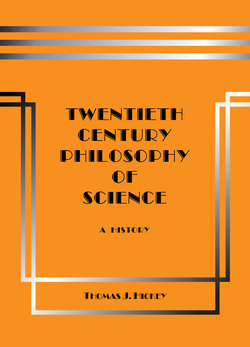Читать книгу Twentieth-Century Philosophy of Science: A History (Third Edition) - Thomas J. Hickey - Страница 119
На сайте Литреса книга снята с продажи.
Scientific Discovery
ОглавлениеDuhem also has a philosophy of scientific discovery. Unlike Mach’s view on discovery and invention in science, Duhem’s is not principally a theory of perception and empirical generalizations. He anticipates later philosophers including the logical positivists with his emphasis on the language of science. For him scientific discovery is not reduced to noticing what had previously been overlooked in perception; for him discovery is also the construction of hypothetical theories.
The construction of a theory involves four successive operations: Firstly certain physical properties are taken as simple, so that other things are combinations of these simple properties. These properties are not simple in any absolute sense like Mach’s elements, but are taken as simple only for purposes of the theory. The simple properties are measured, and the magnitudes are assigned to symbolic variables. Secondly the magnitudes are connected by propositions, i.e., equations that are hypotheses, and that serve as postulates of the deductive system. Thirdly the postulates are not realistic or phenomenalist, but are freely created; using them requires only that the logic of algebra be correctly applied for making deductions. Fourthly the conclusions drawn from the postulates are compared with the experimental laws that the theory is intended to represent and organize.
If the conclusions agree with the laws within the degree of approximation corresponding to the measurements taken in the experiments, then the theory is said to be an acceptable theory. Such acceptable theory may in turn be used for the further development of measuring instruments used in experiments, as well as constituting the final product of the scientific endeavor with its maximum economy. Improved theory produces improved instruments, which in turn produce better measurements. These better measurements reduce the range of the indeterminacy in the numerical data, which may cause the theories to fail in their predictions. Such failure will occasion two types of responses. The initial response is to modify the theory with corrections, which will enable the predictions made with the theory to fall within the smaller range of indeterminacy produced with improved measurements. But these corrections also complicate the theory, and in due course “good sense” may lead some physicists to decide to refrain from adding more complicating corrections, and instead attempt to revise the hypothetical postulates of the symbolic schema, i.e., of the whole theory itself. The accomplishment of such a revision is the work of the genius.
But Duhem does not subscribe to the heroic concept of invention; history creates the genius as much as the genius creates history. The physicist does not choose the hypotheses on which he will build a new theory; the theory germinates within him. This germination is not sufficiently explained by the contemplation of the experimental laws that the theory must represent. It is a larger cultural development. In due course when the cultural process that he calls universal science has prepared minds sufficiently to receive a new theory, it arises in a nearly inevitable manner. Often physicists who do not know one another and who are working great distances from one another, generate the same theory at the same time. In the course of his studies the historian of science according to Duhem often observes this simultaneous emergence of the same theory in countries far from one another.
